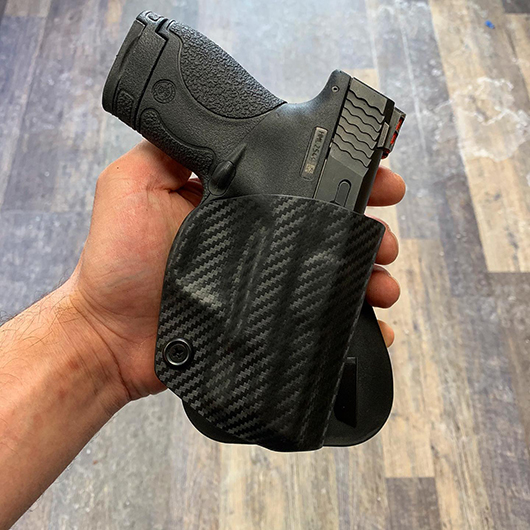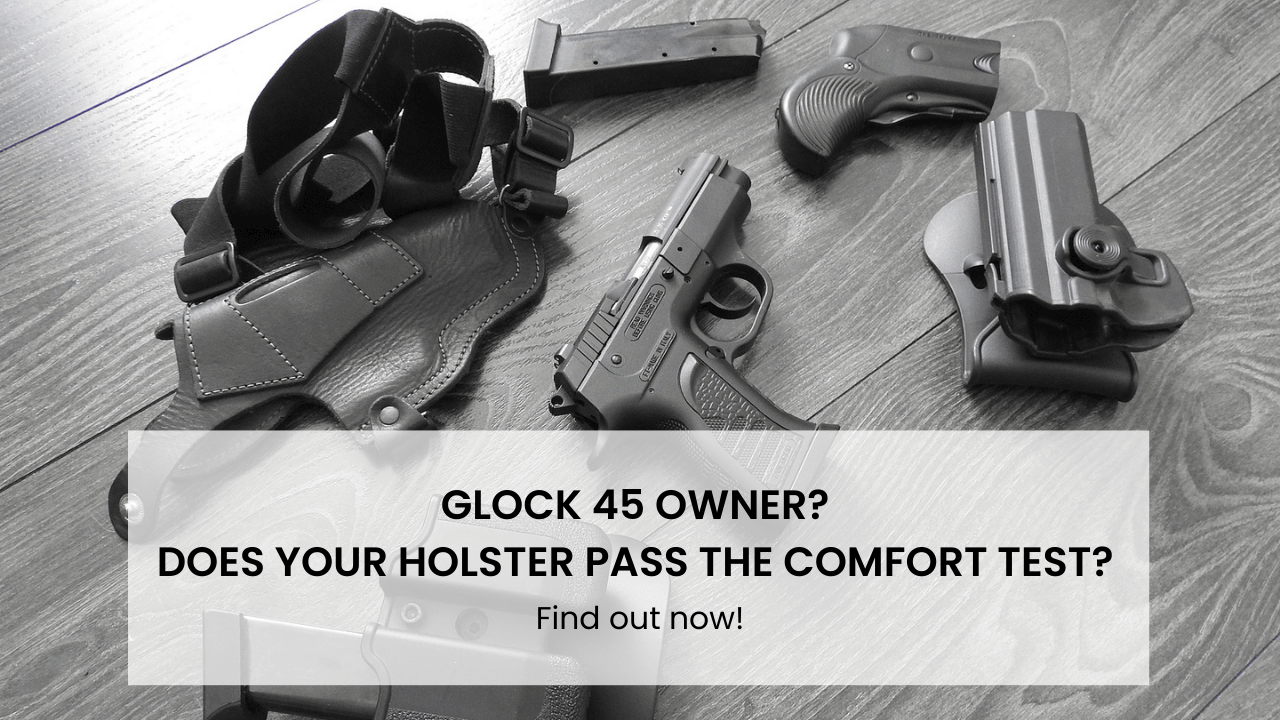Should You Carry a Smith & Wesson Shield IWB?
Aug 25th 2021

The Smith & Wesson M&P is a competitor of the Glock series of firearms. A polymer-framed, striker-fired handgun, the S&W M&P, in its various configurations, has proven suitable for practically every application, from law enforcement to competitive target shooting.
The S&W Shield and Shield M2.0 are micro-compact variants of the M&P, optimized for concealed carry. No matter the size or design, your concealed-carry firearm needs a carry holster that meets the same standards of high quality.
Smith & Wesson M&P 2.0 Holster
About the Shield M2.0
Available in 9mm Luger, .40 S&W, and .45 Auto, the Shield M2.0 ships with two magazines: one standard capacity that fits flush with the frame and one extended. The flush-fit magazine holds seven rounds in 9mm, and six rounds in .40 S&W and .45 Auto.
The extended magazine holds eight rounds in 9mm and seven rounds in the heavier calibers. The Shield M2.0 features front and rear fish-scale charging serrations and an 18° grip angle, which allows you to point the firearm more naturally.
In 9mm, the S&W M&P Shield M2.0 has a barrel length of 3.1”, an overall length of 6.1”, a height of 4.6”, and a width of 0.95”. Weighing 18.3 oz., the Shield M2.0 is comparable with the Glock 43.
The .40 S&W model is dimensionally identical to the 9mm variant, although the weight is 18.1 oz. (one-fifth of an ounce less). The .45 Auto variant has a 3.3” barrel, an overall length of 6.45”, a height of 4.88”, and weighs 20.5 oz.
At these dimensions, regardless of caliber, the Shield M2.0 is a highly concealable weapon that you should be able to carry with the utmost discretion. In addition, the S&W M&P Shield M2.0 is guaranteed by Smith & Wesson’s Lifetime Service Policy.
How to Maximize Concealment
As the Shield is designed for concealment, you need a holster that allows you to take full advantage of its micro-compact frame size. OWB holsters are versatile, but IWB holsters allow for a more discreet carry.
IWB holsters hide part of the holster and the weapon under your pants, between your waistband and your body. When carrying full-size handguns, IWB can be uncomfortable or impractical. For highly compact firearms, IWB is the standard.
Adjustability is Key
Every shooter is different, and you need a holster that you can adjust to suit your individual needs. You should be able to tailor the holster’s ride height, cant, and retention to find the perfect balance between all three.
Ride Height and Cant
In addition to the design of your weapon, your carry position, and your choice of clothing, two factors that affect both concealability and access are ride height and cant. Ride height determines how high or low the holster, and pistol, sit in relation to the center of your waistband.
The higher the ride height, the more space there is between the front strap and the belt, increasing your ability to achieve a full firing grip. A lower ride height increases concealment at the expense of accessibility, as there is less clearance between the weapon and the top of the belt.
The cant complements the ride height and determines the forward or rearward rotation of the weapon in relation to the center of the waistband. A forward cant causes the muzzle to drop and the butt to rise. In addition to improving accessibility when carrying strong side, a forward cant also increases concealment, as the butt prints less through clothing.
Consider Retention
For any concealed-carry weapon, retention is critical. In your everyday life, you shouldn’t have to worry about your weapon being secure. This is both for your safety and the safety of others. While most modern combat handguns, including the Shield, are considered drop safe, no reputable manufacturer will recommend dropping its product on the ground or claim that this is a safe practice. Retention also prevents unauthorized access to your firearm.
A high-quality Kydex holster provides passive retention. As the manufacturer thermoforms the material to conform to the gun’s contours, the holster adheres to points on the frame and slide firmly.
Most Kydex holsters that rely on passive retention (friction) to resist the upward movement and release of the weapon allow you to adjust the retention using one or more screws. By rotating the screws, you can cause the holster to grip the weapon more tightly or more loosely, customizing the pressure needed to free the weapon.
This causes the holster to produce an audible click when you seat the weapon fully. Some regard this as a liability, as drawing and holstering your firearm in a Kydex holster is noisier than leather. Others see this as a valuable type of feedback, signaling that the weapon is fully holstered.

Carry Positions for the Shield M2.0
Shooters typically use hour-hand positions on a clock face to represent different positions in waistband carry. Your strong side is your right hip for a right-handed shooter, either directly on or behind it. On a clock face, that’s typically between 3 and 4 o’clock. If you shoot with your left hand, your strong side generally is between 8 and 9 o’clock.
Strong-side carry, or hip carry, is highly suitable for carrying the M&P Shield. The short frame is less apt to print through clothing. With an appropriate forward cant, the weapon practically disappears.
Having your weapon by your side, under your dominant hand, is a natural carry position for many shooters. It also allows you to increase the distance between your weapon and a perceived threat, should you need to respond to an assailant.
Appendix carry is an increasingly popular carry position due to the rapid draw stroke it enables. When combined with a compact firearm, draping your shirt over the pistol affords a high degree of concealment.
Invest in Belt Clips
Belt clips are an important accessory for an IWB holster. If you select a holster that’s compatible with tuckable belt clips, you can tuck your shirt in between the holster and the waistband, leaving the belt clips exposed. This increases the concealability of your IWB holster for the most discreet waistband-carry option possible.
When carrying using a tuckable holster, you’ll need to practice your draw stroke using this method. Grip the shirt fabric with both hands firmly and pull upward sharply. Place your strong hand on the pistol forcefully, acquiring a full firing grip, and draw your weapon. Appendix-carry positions generally only require a neutral or vertical cant.
You should experiment with a range of different belt clips to find the ones that offer the best combination of security and discretion.
Your choice of belt clip also makes a difference. Under most circumstances, passersby will not be able to identify what these are. A more watchful observer may. In the interest of concealment, you should attempt to match your belt clips in color and texture to your gun belt.
Safety First
It’s critical to keep your finger off the trigger until you have your sights on the target. For purposes of reflexive shooting and shooting from retention, you can also abide by the rule that you should keep your finger off the trigger until the muzzle is pointed toward the target.”
Regardless of your shooting method, however, your index finger should be straight alongside the trigger guard, the frame, or the slide as you place your hand on the grip and perform the draw.
A good gun holster should have material covering the trigger guard, preventing anything, whether a finger or foreign debris, from contacting the trigger until the weapon is free from the holster.
This can prevent unintentional discharges under stress, unauthorized access to your weapon, and accidents due to clothing or obstacles in the environment.
Protective Sweat Guard
IWB holsters are held close to the body and are often worn during the spring and summer months when the temperature can render the wearing of cover garments impractical. As a result, the pistol is more susceptible to encountering sweat. Although the Shield’s stainless-steel slide features the Armornite® finish for added corrosion resistance, sweat is known for its corrosive properties.
One of the simplest methods of protecting your weapon is to wear a holster with a protective barrier, reducing contact between your body and the firearm. This is called a sweat guard or shield. A sweat guard is the rear part of the holster that extends upward, partially or fully, covering the slide and preventing it from contacting your skin or clothing.
Why Kydex?
Leather holsters are still a popular choice due to their comfort and classic style. Nylon holsters are inexpensive and can fit various weapons without the need for custom molding. However, Kydex — an aircraft-grade thermoplastic developed more than 50 years ago — has become an increasingly common choice among firearms enthusiasts, law enforcement, and military professionals.
In addition to its strength, Kydex is lightweight, impervious to water and chemical contamination, and, above all, rigid. The rigidity of Kydex is one of its advantages over other holster materials. The thermoforming process ensures there’s a perfect fit between the gun and the holster every time.
Unlike leather, which can deform from regular use, and nylon, which provides limited structural support, Kydex is hard and maintains its shape. Soft holster mouths that collapse require you to use two hands to reholster your firearm. This can cause safety challenges, especially if the risk of covering your support hand with the muzzle increases. Pliable holster materials can also reduce the retention necessary to secure your weapon.
Loose or non-rigid fabric or animal-hide holsters also pose an additional safety challenge. During the reholstering process, if foreign material enters the trigger guard, the pressure from the downward stroke can inadvertently activate the trigger, firing the weapon.
A rigid, non-deformable material, such as Kydex, ensures that the holster mouth remains open and intact at all times. However, this doesn’t absolve you of the responsibility of exercising caution when reholstering your firearm.
Carry Extra Ammo
The Shield M2.0 magazine holds between six and eight rounds, depending on caliber and whether the magazine is flush fit or extended. As a result, you may decide to carry spare ammunition on your belt. Kydex magazine carriers also called magazine pouches, provide a retention-adjustable means of carrying one or two extra magazines.
Parting Thoughts
The Smith & Wesson Shield M2.0 pistol is a superb choice for a concealed-carry weapon, offering three calibers, a compact and lightweight frame, and Smith & Wesson’s proven reliability. No concealed-carry handgun is complete, however, without a well-crafted, functional holster.
At Incognito Concealment, we specialize in manufacturing custom-molded Kydex products for a range of handguns at a great price. If you’re in the market for OWB or IWB Kydex holsters, mag pouches, or belt clips made with pride in the United States, check out our products. Alternatively, give us a call, and we’ll help you find the best holster for your particular circumstances and answer any questions you may have. Whether you’re interested in concealed or open carry, we have the equipment you need.











